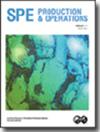直井和中等斜度井中层间流量的测定
IF 1.3
4区 工程技术
Q2 ENGINEERING, PETROLEUM
引用次数: 0
摘要
准确的层带流速测定对于更好地理解储层动态和做出能够提高井产能的重要决策是必要的。了解同一口井中不同储层带的能力对于储层性能监测和开发井射孔层段的选择也具有重要意义。传统的生产测井分析技术通常只有在全径旋转器读数可靠的情况下才能产生良好的结果。但是,在某些油井中可能无法使用全径旋转器测量。例如,由于机械阻碍,或套管不够干净,导致全径旋转器叶片可能堵塞,全径旋转机无法进入油井。在这些情况下,全径流量读数可能不可用,或者至少不清楚或令人困惑,这可能导致错误的决定。在许多这样的情况下,内联微调器(ILS)数据可能很容易获得。ILS通常用于定性解释(即确定产生的区域),但在没有速率表面测量的情况下,没有具体的方法将ILS用于定量解决方案。本文介绍了一种利用ILS数据高精度计算体积纬向流速的新方法。大约有40口油井用于开发经验相关性,以根据套管柱中的ILS数据计算区域流速。该新方法用于对8口油井进行定量解释以进行验证。在这些井中,全井眼和ILS数据存在显著差异。ILS数据解释的新方法提供了与地面生产测试一致的结果,并导致了有助于提高生产率的决策。本文章由计算机程序翻译,如有差异,请以英文原文为准。
Use of Inline Spinner for Determination of Zonal Flow Rates in Vertical and Moderately Deviated Wells
Accurate zonal flow rate determination is necessary for better reservoir behavior understanding and for making important decisions that can improve well productivity. Knowledge of the capabilities of different reservoir zones in the same well also has significant importance in reservoir performance monitoring and selection of perforation intervals in development wells.
Conventional production log analysis techniques can usually yield good results only if the fullbore spinner readings are reliable. However, the fullbore spinner measurement may not be available in some wells. Examples include cases in which the fullbore spinner cannot access the well due to mechanical obstruction, or when the casing is not clean enough, causing potential plugging of fullbore spinner blades. In these situations, the fullbore flow-rate readings may not be available or at least unclear or confusing, which may lead to incorrect decisions. In many of these situations, inline spinner (ILS) data may be readily available.
The ILS is often used for qualitative interpretation (i.e., determining which zones are producing), but there is not a specific method to use the ILS for a quantitative solution in the absence of surface measurements of rates. In this paper, we introduce a new method to calculate the volumetric zonal flow rate using ILS data with high accuracy. Approximately 40 oil wells are used to develop an empirical correlation to compute zonal flow rates from ILS data in casing strings. The new method was used to quantitatively interpret eight oil wells for validation. In these wells, fullbore and ILS data were significantly different. The new method for interpretation of ILS data provided results consistent with surface production tests and led to decisions that contributed to increasing production rates.
求助全文
通过发布文献求助,成功后即可免费获取论文全文。
去求助
来源期刊

Spe Production & Operations
工程技术-工程:石油
CiteScore
3.70
自引率
8.30%
发文量
54
审稿时长
3 months
期刊介绍:
SPE Production & Operations includes papers on production operations, artificial lift, downhole equipment, formation damage control, multiphase flow, workovers, stimulation, facility design and operations, water treatment, project management, construction methods and equipment, and related PFC systems and emerging technologies.
 求助内容:
求助内容: 应助结果提醒方式:
应助结果提醒方式:


